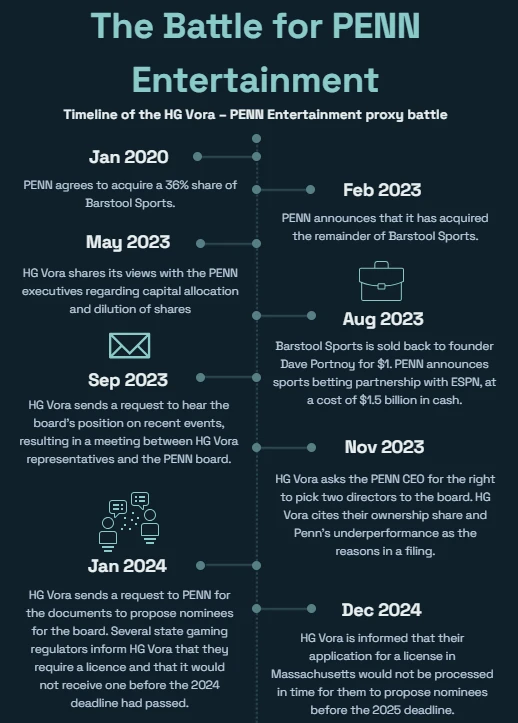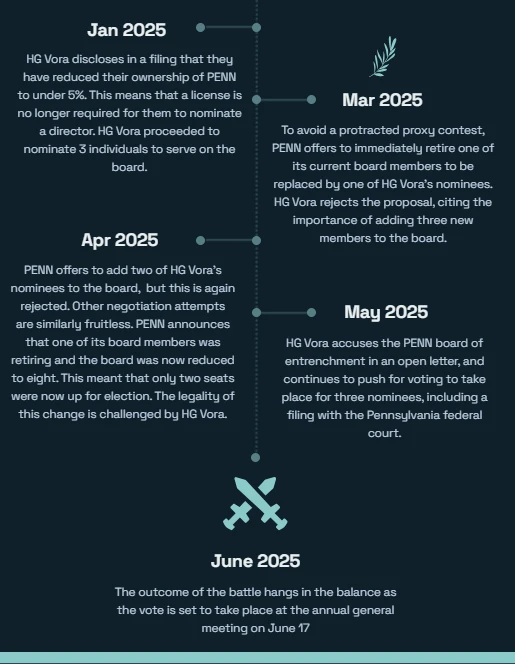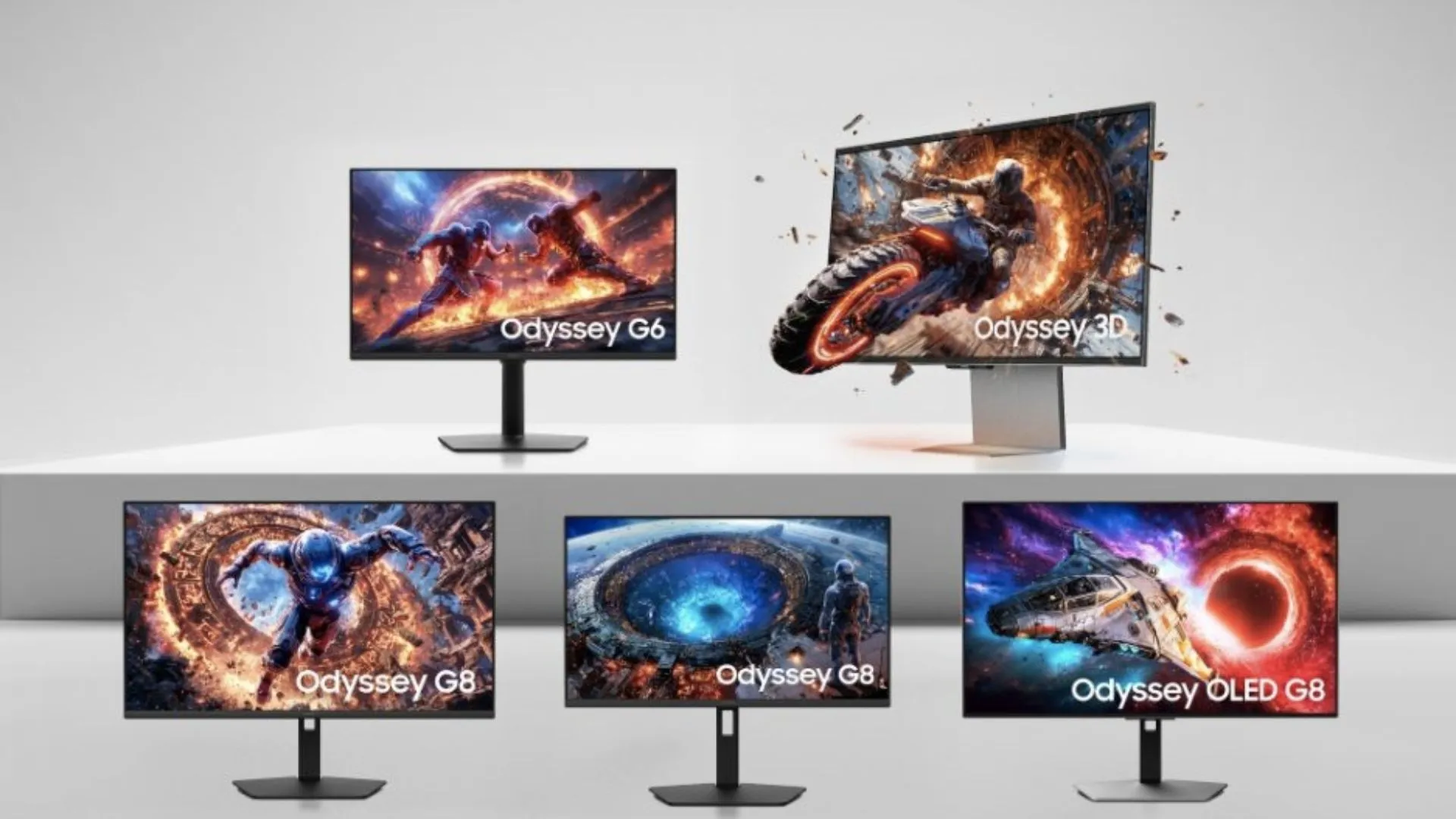Technology
Penn elects two directors, but proxy fight is far from settled

Penn shareholder meeting highlights dispute over board members that is also the focus of a federal lawsuit by HG Vora.
For a gambling-industry event as hyped as any shareholders gathering since the historic PASPA decision, Penn Entertainment’s annual shareholder meeting on Tuesday largely failed to bring the sizzle.
As expected, Penn shareholders elected Johnny Hartnett and Carlos Ruisanchez to the gaming company’s board of directors as part of a continued reshuffling of the board. Their additions were sought by HG Vora Capital Management, a top Penn shareholder.
But Penn did not consider the nomination of William Clifford, a third independent director sought by HG Vora. Clifford’s nomination represents a key sticking point in contentious discussions regarding the future composition of the board.
At the conclusion of the 10-minute, 30-second meeting, Penn CEO Jay Snowden announced the election of Hartnett and Ruisanchez, based on the preliminary results of the vote. But without a resolution to Clifford’s nomination, the brief meeting ended on an anti-climactic note. As a court hearing in HG Vora’s lawsuit against Penn over board seats approaches next month, the meeting arguably produced more questions than answers.
Penn: Nomination of Clifford ‘out of order’
Speaking on behalf of HG Vora, a New York-headquartered hedge fund, Mandy Lamb put forth Clifford’s nomination at Tuesday’s meeting. Clifford has deep experience with Penn, where he formerly served as the company’s chief financial officer for nearly 13 years. He left the company in November 2013, seven years before Snowden’s appointment as CEO, to join Gaming Leisure and Properties.
Snowden abruptly dismissed Lamb’s proposal, immediately quashing any possibility for the election of a third director. Pursuant to Penn company bylaws, the board set the number of Class II directors at two, Snowden stated. He deemed a proposal to nominate a third director as “out of order” and not permissible.
The proxy battle on board composition has been the subject of an intense months-long dispute between Penn and the hedge fund. Since his departure, Clifford subsequently interviewed with Penn for a position on the board in 2020.
Penn indicated that it still has some of the same concerns on Clifford’s expertise in digital gambling that it raised five years ago. In a May letter to shareholders, Penn asserted that Clifford lacked digital gaming and online sports betting experience, areas that are “essential to the future” of its business.
Federal lawsuit
In May, HG Vora filed a lawsuit against Penn accusing the company of violating Pennsylvania Business Corporation law. The suit also accuses Penn of breaching its fiduciary duty by reducing the number of seats available on the board. In response, Penn filed a motion to stay, urging a Pennsylvania court to temporarily halt legal proceedings. According to Penn, the merits of HG Vora’s claim do not “constitute good cause”.
In addition, Penn argued that the plaintiffs have not established likelihood of “imminent and irreparable harm”. There, Penn addressed HG Vora’s arguments on board composition. Speculation about a future board action cannot constitute “good cause”, Penn contends. A speculative matter is not even a dispute ripe for adjudication, Penn added, because it rests upon contingent future events that may not occur as anticipated, or may not occur at all.
Penn also criticised HG Vora for its failure to abide by disclosure standards in other instances. The Securities and Exchange Commission announced a $950,000 settlement with the fund in March 2024 for its failure to make timely ownership disclosures in the lead-up to a May 2022 acquisition bid for trucking fleet company Ryder System Inc.
According to the SEC, HG Vora disclosed that it owned 5.6% of Ryder’s common stock as of 31 December 2021 and certified that it did not have a control purpose. The fund subsequently built its position to a 9.9% stake in the first half of 2022 and formed a control purpose in May of that year. However, HG Vora did not make the proper disclosures until 13 May 2022, the same day it made a proposal to buy all of Ryder’s shares for $86 a share, a sizeable premium over the trading price.
HG Vora trots out the Gold card
Ahead of Tuesday’s meeting, HG Vora urged shareholders to vote using its “gold card,” which featured the nominations of all three directors. By noon on Tuesday, more than 55% of all votes cast in the election were submitted on the gold cards, HG Vora wrote in a statement.
At the same time, HG Vora claimed that approximately five of Penn’s top 30 institutional investors voted on the company’s white proxy card, based on preliminary tabulations from the fund’s proxy solicitor, Okapi Partners.
“Penn’s shareholders have voted overwhelmingly for genuine change, including for the election of William Clifford to the board,” said Parag Vora, founder of HG Vora. “There can be no mistake about the mandate from Penn’s shareholders that the status quo is simply unacceptable.”
Institutional ownership
The nasty proxy battle may serve as an example for major sportsbook operators on how to handle disputes from activist investors. In a memo issued by Penn Entertainment last month, the company claimed that HG Vora violated several institutional investor waivers in which they agreed to remain passive in their activities. Furthermore, Penn asserted that the fund pushed for governance changes despite express prohibitions on doing so by state gaming regulators.
For its part, the hedge fund retorted that it does not consider itself to be an activist investor. To buttress its point, attorneys for HG Vora wrote in the suit that the Penn nominations marked the first time in the 16-year history of the fund that it nominated director candidates for a company in its portfolio. Over that span, HG Vora has invested in hundreds of firms.
In a Schedule 13D filing with the SEC issued on 28 December 2023, HG Vora disclosed an ownership stake of approximately 9.6% of Penn’s outstanding common stock. By the following December, representatives for the fund appeared in Massachusetts for a licensing hearing. According to the lawsuit, HG Vora contends that it sought an emergency hearing with the Massachusetts Gaming Commission (MGC) in order to obtain a gaming licence or limited relief in Massachusetts to be in a position to nominate candidates to the Penn board.
Reduced holdings
After the MGC denied HG Vora’s request for relief, the fund decided to shave its holdings in Penn for licensing purposes. Weeks later, HG Vora disclosed in a 13D filing that the fund reduced its ownership in the company’s common stock by approximately half to 7.25 million shares, representing an equity stake at the time of 4.8%.
According to TipRanks.com, a leading market research website, there is considerable institutional ownership in Penn, with 86.7% of shares held by institutional investors.
Beyond HG Vora, three others maintain a stake of at least 4%, led by iShares which tops the list at 11.4%.

Speaking on the sidelines of Wednesday’s Canadian Gaming Summit, Canadian Gaming Association CEO Paul Burns told iGB that the gaming industry is “in a fascinating spot” at the moment. He was responding to a question on how the Penn matter can become a template for other proxy battles throughout the industry.
One avenue to explore surrounds the mix of private equity investment. As Burns points out, the shift could be interesting since the private equity community maintained a relatively low appetite for sportsbook operators before PASPA.

Investment into digital gaming
Before Penn’s foray into online sports betting, HG Vora lauded the company for its execution on the retail gaming side. The fund pointed to Penn’s financial results in the second quarter of 2015, a period where Penn delivered a strong balance sheet favourable by industry standards in terms of net debt leverage and interest coverage.
Its criticism, however, centres on Penn’s spending habits in growing its digital gaming business. Penn is in the middle of a 10-year, $1.5 billion deal with the Walt Disney Co that led to the launch of ESPN BET.
The August 2023 partnership was announced on the same day that Penn sold Barstool Sports back to Dave Portnoy for $1. In total, Penn had spent in excess of $400 million to purchase Barstool.
A major purchase, eh?
With the Disney deal, Penn essentially swapped Barstool Sportsbook for ESPN BET as its front-facing sportsbook brand. At the time, Snowden had ambitions to hit 20% online sports betting market share by the end of 2027. But as the two-year anniversary of the deal nears, ESPN BET’s nationwide market share still hovers in the low single digits. The deal also came on the heels of Penn’s acquisition of Score Media and Gaming Inc for approximately $2.1 billion.
TheScore, a digital media, sports betting and technology company, is one of the most popular sports apps in Canada. At Wednesday’s conference, Burns gave theScore high marks for its tech platform.
Others, though, have questioned the cost of the Score acquisition, considering other subsequent deals such as Fanatics purchasing PointsBet’s US assets for $150 million. An industry tech consultant speaking to iGB on condition of anonymity this week believes Penn could have waited for valuations to moderate, noting that “timing is half of everything”.
An inflection point?
In attempts to grow its online business, Penn may spend at least $4 billion, HG Vora estimates. Both Penn and ESPN have an opt-out at the end of the third year, which Snowden noted could be exercised by either company if they believe ESPN BET has underperformed. HG Vora has advised Penn to abandon its online division. Based on comments from Snowden on a recent earnings call, such a move appears to be a longshot at best.
“Our digital business continues to evolve, supported by our well-known brand-differentiated IP, a fully owned technology stack and newly recruited, industry-leading talent,” said Snowden on Penn’s first-quarter earnings call. “We are nearing an inflection point.”
Penn is also bullish on a new initiative that enables customers to link their accounts between ESPN BET and the main ESPN app. The features combined with the rollout of ESPN’s new streaming service have Penn Chief Technology Officer Aaron Laberge intrigued by the “bespoke integrations” he said will be unique to the market. ESPN BET will look to the football season to provide customers with new personalised offerings that integrate their sports betting and fantasy sports selections with a quick thumbprint.
Despite Penn’s financial challenges, it is important to remember that top gambling names are valued in many cases as Software-as-a-Service (SaaS) stocks. Stocks in the class are long-dated, high-growth companies in the tech sector. Amazon, for instance, took years to first turn a profit. Nevertheless, questions remain if investors such as HG Vora will exercise enough patience before attempting to execute major change.
Executive compensation
For HG Vora, executive compensation is a major point of contention. In April 2021, Penn’s board awarded Snowden supplemental equity grants worth nearly $200 million keyed to certain price targets, according to HG Vora. Those grants have incentivised Penn’s attempts to grow Penn’s digital business without exercising enough financial restraint, the fund contends.
Snowden’s compensation of $26.7 million in 2024 ranked second-highest for CEOs among a group of approximately a dozen peer companies, according to HG Vora. Penn, however, disputed some of the findings.
Snowden’s realisable pay represents only 45% of his reported compensation and is in the bottom quartile relative to the company’s proxy peer group, the company wrote in the memo. Snowden has only exercised expiring options and has not sold any stock since 2021. Moreover, the transactions were only conducted to cover the strike price and taxes, according to Penn.
Next steps
Since 2020, Penn executives and directors have purchased over $5.7 million worth of stock in the open market using their personal funds, including $2.8 million by Snowden. Of the amount, Snowden made $1.5 million in purchases over the last 10 months, according to Penn.
The insider activity may not assuage the fund. In 2024, the Institutional Shareholder Services gave Penn a score of -100 on its “Pay-For-Performance” evaluation, a comparatively low rating that reflects high pay for low performance, according to HG Vora.
Meanwhile, share advisory service Glass, Lewis & Co gave Penn low marks for compensation levels relative to performance against its peers. More than 60% of the votes cast in the election were against Penn’s Say-On-Pay proposal, according to HG Vora.
Penn did not respond to a request from iGB for comment.
On 10 July at the federal courthouse in Easton, Pennsylvania, Penn and HG Vora have a case management conference scheduled in the fund’s lawsuit.
On Nasdaq on Wednesday, Penn closed at $17.28 a share, up nearly 5% on the session. Shares in Penn are down sharply since hitting an all-time high of $142 in March 2021
Technology
Page not found
Technology
Samsung to showcase world’s first 1,040Hz gaming monitor at CES 2026

Samsung Electronics has unveiled its new most advanced Odyssey gaming monitor lineup. The lineup includes five new models that push the boundaries of resolution, refresh rates, and immersive visual performance.
Led by Samsung’s first 6K 3D Odyssey G9, the 2026 lineup debuts world-first display technologies for gamers and creators, including the next-generation Odyssey G6 and three new Odyssey G8 models.
First 6K glasses-free 3D monitor
“With this year’s Odyssey lineup, we’re introducing display experiences that simply weren’t possible even a year ago,” said Hun Lee, Executive Vice President of the Visual Display (VD) Business at Samsung Electronics.
“From the industry’s first 6K glasses-free 3D monitor to breakthrough 1,040Hz speed, we designed these monitors to meet the ambitions of today’s gamers and deliver a level of immersion that fundamentally changes how content looks and functions on screen.”
The 32-inch Odyssey 3D (G90XH model) debuts the world’s first 6K display with glasses-free 3D, introducing a new way to experience games on a monitor. Powered by real-time eye tracking, it adjusts depth and perspective in response to the viewer’s position, creating a layered sense of dimension for smooth, uninterrupted gameplay without the need for a headset, according to a press release.
PC gamers can enjoy high-quality expanded lineup
With 6K resolution, a 165Hz refresh rate boosted to 330Hz through Dual Mode, and 1ms response time, fast action stays sharp and smooth, according to Samsung.
The company claims that PC gamers can enjoy a high-quality expanded lineup of supported titles with optimized 3D effects developed in collaboration with game studios. Featured games such as The First Berserker: Khazan, Lies of P: Overture, and Stellar Blade will offer added dimensionality, enhancing terrain, distance, and object separation beyond standard 2D gameplay.
The South Korean company has also highlighted that the 27-inch Odyssey G6 (G60H model) gaming monitor advances competitive gaming with the world’s first 1,040Hz gaming monitor through Dual Mode and native QHD support up to 600Hz, delivering esports-level motion clarity to help players track targets and see fine details during high-speed movement.
When needed, the Odyssey G6 can boost performance in an instant, providing ultra-sharp resolution so viewers can experience breathtaking worlds and ultra-high speeds that fuel competitive adrenaline. With support from both AMD FreeSync Premium and NVIDIA G-Sync Compatible, the Odyssey G6 ensures that every frame is smooth, every color pops, and every moment feels responsive.
The Odyssey G8 series is expanding in 2026 with three distinct models, each offering a different balance of resolution and speed. Leading the lineup, the 32-inch Odyssey G8 (G80HS model), the industry’s first 6K gaming monitor, delivers native 165Hz performance with Dual Mode that supports up to 330Hz in 3K mode.
The 27-inch Odyssey G8 (G80HF model) offers a sharper 5K option with native support up to 180Hz, and Dual Mode boosts to 360Hz in QHD for smoother motion.
For users who want deeper contrast, the 32-inch Odyssey OLED G8 (G80SH model) pairs a 4K QD-OLED panel with a 240Hz refresh rate, Glare Free viewing, 300-nit brightness, and VESA DisplayHDR True Black 500 certification. Its DisplayPort 2.1 (UHBR20) supports up to 80 Gbps of bandwidth for seamless HDR and VRR playback, according to Samsung.
The complete Odyssey 2026 lineup will be on display at CES 2026 in Las Vegas from January 6-9.
Technology
Games of the Future Abu Dhabi 2025 Rewrites the Playbook for Sports with Phygital Innovation
Published on
December 25, 2025
By: Tuhin Sarkar

The Games of the Future Abu Dhabi 2025 have closed an unforgettable chapter in the evolution of phygital sports. Hosted under the patronage of His Highness Sheikh Mohamed bin Zayed Al Nahyan, President of the UAE, the event marked an unparalleled fusion of physical and digital competition. Over six action-packed days, Abu Dhabi hosted more than 850 participants from 60+ countries, with fierce battles across 11 disciplines including Phygital Football, Phygital Basketball, esports, Phygital Fighting, drone racing, and VR gaming.
Games of the Future Abu Dhabi 2025 was not just a sporting event; it was a vision of the future. It set a global standard for what sports can look like in the digital age, where technology and human skill come together to create immersive and multi-dimensional experiences. The competition showed the world that the future of sports isn’t confined to a physical arena, but seamlessly integrates both the physical and digital.
The Champions of Tomorrow: Phygital Sports Takes Centre Stage
The Games of the Future Abu Dhabi 2025 featured 11 disciplines that blended traditional sports with futuristic technologies, including Phygital Football, Phygital Basketball, esports, Phygital Fighting, and Phygital Shooter. These unique formats tested competitors in both the physical and digital realms. For example, Phygital Football powered by ADNOC saw the México Quetzales – Armadillos FC clinch the Phygital Football title, defeating Troncos FC 2-4 in a thrilling final that captivated crowds throughout the week. Likewise, in Phygital Basketball, the LIGA PRO TEAM triumphed in a 29-23 victory over Moscowsky.
Other high-stakes competitions included Phygital Fighting.FATAL FURY: City of the Wolves, where Kuznya dominated, winning all four of their matches. Meanwhile, xGoat emerged victorious in the Phygital Shooter.CS 2 final, overcoming Dontsu Esports 2-0 in an intense digital shootout.
In the drone racing category, Drone Racing One wowed spectators by completing 50 laps of a challenging circuit, showcasing the high-tech thrill of phygital racing.
A Digital Revolution: The Rise of VR Gaming and Esports
Beyond traditional sports, Games of the Future Abu Dhabi 2025 brought esports and VR gaming into the spotlight. The esports events featured top teams and intense matches across a variety of games, including MOBA Mobile.MLBB and MOBA PC.Dota 2. In a thrilling final, ONIC defeated Aurora Gaming in the Mobile.MLBB championship, while teamWin overcame Vikings 2-0 in Dota 2.
The Battle Royale tournament, featuring Fortnite, saw Kami + Swizzy crush their opponents ZYRO + RAPID in the final. In VR gaming, the HADO competition proved to be one of the most exciting events, where Team Rock claimed the victory.
The digital revolution didn’t stop there—Phygital Dancing.Just Dance was an engaging crowd favorite, with Ivan “myakekcya” Vlasov taking home the crown. These events proved that esports and VR gaming are no longer just niche interests but are now integral parts of mainstream competition.
The Future is Phygital: Tech and Sport in Perfect Harmony
Games of the Future Abu Dhabi 2025 perfectly illustrated how technology and sports are converging to form an entirely new ecosystem. With events such as Phygital Football, Phygital Basketball, and drone racing, the Games were a showcase of the groundbreaking possibilities that arise when sports embrace digital innovations. Technology was not merely an accessory at this event—it was the cornerstone upon which the competitions were built.
With immersive experiences that brought together digital avatars, VR environments, and physical action, the event revealed a new way of experiencing and consuming sports. It also showcased how athletes and fans alike can now engage with sports in ways that were unimaginable just a decade ago.
Abu Dhabi Leads the Way: A Global Hub for Next-Generation Sports
As the host city, Abu Dhabi solidified its position as a global leader in the future of sports. This landmark event wasn’t just about showcasing phygital sports, but also about demonstrating the UAE’s commitment to innovation and technology. The event was a triumph of vision, execution, and global collaboration, bringing together athletes, clubs, and partners from around the world.
In his remarks, Saif Al Noaimi, CEO of Ethara, remarked on the complexity of delivering an event on such a grand scale: “Delivering an event of this scale and complexity required close coordination across multiple disciplines, venues, and partners. The Games of the Future Abu Dhabi 2025 showcased competitive excellence, but also operational innovation and audience engagement at the highest level.”
Similarly, Nis Hatt, CEO of Phygital International, praised the event’s impact: “What we saw over six days was not just competition, but the emergence of a global ecosystem where sport, esports, technology, and innovation coexist on one stage. Abu Dhabi set a new benchmark for scale, delivery, and ambition.”
A Glimpse into the Future: The Global Impact of Phygital Sports
The success of Games of the Future Abu Dhabi 2025 is not just about the event itself. It signals a transformative shift in how we view and experience sports in the 21st century. By embracing phygital sports, the UAE is not just shaping the future of competition, but also setting the stage for the next generation of athletes, fans, and sports industries.
The Phygital Sports Summit, which took place during the event, provided a platform for discussing the future of sports, technology, and innovation. The summit brought together industry leaders, athletes, and tech visionaries to discuss the convergence of physical and digital realms. The dialogue held here will help define the future trajectory of phygital sports and shape the policies that govern it.
Looking Ahead: The Future of Phygital Sports is Now
The Games of the Future Abu Dhabi 2025 wasn’t just a flash in the pan; it was a statement. The event demonstrated how sports and technology can work in harmony, paving the way for the next generation of competition. As Abu Dhabi continues to innovate and lead the way in phygital sports, the rest of the world is watching closely, eager to follow in the footsteps of this global hub for next-generation sports and entertainment.
As Stephane Timpano, CEO of ASPIRE, pointed out, “The success of this edition shows what is possible when vision, technology, and execution align.” The Games of the Future Abu Dhabi 2025 will undoubtedly serve as a springboard for even bigger, more ambitious events in the years to come, setting a new standard for what’s possible in the world of sports.

Technology
The Games of the Future Abu Dhabi 2025 Closes Landmark Edition, Setting New Benchmark for Phygital Sports


GOTF 1

Concludes GOTF.2

Concludes GOTF .3
ABU DHABI, UNITED ARAB EMIRATES, December 25, 2025 /EINPresswire.com/ — The Games of the Future Abu Dhabi 2025 powered by ADNOC concluded on Tuesday after six days of elite competition, innovation, and global participation, marking a milestone moment in the evolution of phygital sports.
Held under the patronage of His Highness Sheikh Mohamed bin Zayed Al Nahyan, President of the UAE, the landmark event brought together more than 850 participants from over 60 countries and featured 11 disciplines, spanning Phygital Football, Phygital Basketball, esports, Phygital Fighting, Phygital Shooter, Phygital drone racing, and VR Game.HADO. Across arenas, stages, and digital battlegrounds, the event showcased how technology and sport are converging to shape the future of competition.
During the globally-watched event, champions were crowned in each discipline, delivering their own defining moments and reinforcing the unique multi-sport identity of the Games of the Future.
Phygital Football powered by ADNOC and Phygital Basketball.3on3 FreeStyle brought to you by M42 both drew vocal crowds throughout the week, with MÉXICO QUETZALES – ARMADILLOS FC taking the Phygital Football title in a thrilling 2-4 final win over Troncos FC, and LIGA PRO TEAM secured the Phygital Basketball title with a 29-23 victory over Moscowsky. Meanwhile, in Phygital Fighting.FATAL FURY: City of the Wolves, Kuznya finished top of the leaderboard after winning all four of their fights, dominating both on the digital stage and in the octagon, and xGoat won the Phygital Shooter.CS 2 final, beating Dontsu Esports 2-0 in the digital world to avoid the need for a deciding round of physical laser tag.
Tasting glory in the esports-focused disciplines, ONIC won the MOBA Mobile.MLBB final against Aurora Gaming, while the aptly-named teamWin beat Vikings 2-0 in the championship game of MOBA PC.Dota 2, and Kami + Swizzy conquered ZYRO + RAPID in the final of the Battle Royale.Featuring Fortnite. In the Phygital Drone Racing presented by InsuranceMarket.ae, which tasked clubs to complete 50 laps of a testing circuit filled with loops, hoops, and straights, Drone Racing One proved fastest on the final day ahead of Team BDS.
A pair of events taking place in the Atrium at ADNEC Centre drew plenty of attention as Ivan “myakekcya” Vlasov triumphed in the Phygital Dancing.Just Dance final, while Team Rock took the title in VR-game.HADO. Lastly, in Battle of Robots, proving itself one of the most spectacular disciplines of the week, Fierce Roc’s menacing Deep Sea Shark machine annihilated Team Cobalt’s Cobalt in a spectacularly destructive finale.
In parallel with the competitive program, the event week also featured an eye-catching and engaging Opening Ceremony and the inaugural Phygital Sports Summit, reinforcing Abu Dhabi’s position as a global hub for next-generation sport, innovation, and immersive entertainment.
Saif Al Noaimi, CEO of Ethara, reflected on intricacy of the Games: “Delivering an event of this scale and complexity required close coordination across multiple disciplines, venues, and partners. The Games of the Future Abu Dhabi 2025 showcased competitive excellence, but also operational innovation and audience engagement at the highest level. We are proud to have played a role in bringing this landmark event to life and in supporting its growth on the global stage.”
Nis Hatt, CEO of Phygital International, said: “The Games of the Future Abu Dhabi 2025 demonstrated how far this movement has come in a short space of time. What we saw over six days was not just competition, but the emergence of a global ecosystem where sport, esports, technology, and innovation coexist on one stage. Abu Dhabi set a new benchmark for scale, delivery, and ambition, and this edition has reinforced the Games of the Future as a defining platform for next-generation competition worldwide.”
Stephane Timpano, CEO of ASPIRE, added: “Hosting the Games of the Future in Abu Dhabi reflects the UAE’s commitment to shaping the future of sport and innovation. This event brought together athletes, clubs, partners, and audiences from around the world. The success of this edition shows what is possible when vision, technology, and execution align, and it positions Abu Dhabi firmly at the forefront of emerging sport formats.”
The Games of the Future Abu Dhabi 2025 is organized by ASPIRE, the Local Delivery Authority, in collaboration with Ethara, the Event Delivery Partner, and Phygital International, the Global Rights Holder. The event is supported by key partners, including Abu Dhabi Sports Council, ADNOC, EDGE, M42, Solutions+, The Galleria, Abu Dhabi Gaming, du Infra, InsuranceMarket.ae, Ministry of Sports, Advanced Technology Research Council, and ADNEC Group.
Deepra Ahluwalia
Action Global Communications
+971 56 477 0995
email us here
Legal Disclaimer:
EIN Presswire provides this news content “as is” without warranty of any kind. We do not accept any responsibility or liability
for the accuracy, content, images, videos, licenses, completeness, legality, or reliability of the information contained in this
article. If you have any complaints or copyright issues related to this article, kindly contact the author above.
![]()
Technology
3D Glasses-Free Gaming Monitors : Samsung Odyssey 3D G90XH
The Samsung Odyssey 3D G90XH gaming monitor features a 165Hz refresh rate that can be boosted to 330Hz in Dual Mode. The monitor is slated to arrive in 2026 and is expected to be a hit amongst avid gamers.
Technology
Stunning Stacked LED Displays : LG Display OLED technology
The Tandem WOLED technology will offer fast response time, high refresh rates, low motion blur, dual modes, enriched color depths and more. The Tandem OLED technology will allow screens to blend more seamlessly into everyday spaces thanks to its natural performance.
The latest LG Display OLED technology comes as part of the company’s rebranding of its screen technology to help usher in a new age for the brand.
-

 NIL3 weeks ago
NIL3 weeks agoDeSantis Talks College Football, Calls for Reforms to NIL and Transfer Portal · The Floridian
-

 Sports3 weeks ago
Sports3 weeks ago#11 Volleyball Practices, Then Meets Media Prior to #2 Kentucky Match
-

 Motorsports3 weeks ago
Motorsports3 weeks agoNascar legal saga ends as 23XI, Front Row secure settlement
-

 Motorsports3 weeks ago
Motorsports3 weeks agoSunoco to sponsor No. 8 Ganassi Honda IndyCar in multi-year deal
-

 Sports2 weeks ago
Sports2 weeks agoMaine wraps up Fall Semester with a win in Black Bear Invitational
-

 Rec Sports3 weeks ago
Rec Sports3 weeks agoWNBA’s Caitlin Clark, Angel Reese and Paige Bueckers in NC, making debut for national team at USA camp at Duke
-

 Motorsports2 weeks ago
Motorsports2 weeks agoRoss Brawn to receive Autosport Gold Medal Award at 2026 Autosport Awards, Honouring a Lifetime Shaping Modern F1
-
Motorsports3 weeks ago
NASCAR, 23XI Racing, Front Row Motorsports announce settlement of US monopoly suit | MLex
-

 Sports3 weeks ago
Sports3 weeks agoPinterest predicts the biggest Gen Z trends of 2026 | News
-

 Rec Sports3 weeks ago
Rec Sports3 weeks agoRiverhead hires Melissa Edwards as its new athletic director

































